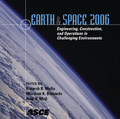Advantages of Modularity and Commonality in a Spacecraft Architecture
Publication: Earth & Space 2006: Engineering, Construction, and Operations in Challenging Environment
Abstract
With the eyes of NASA and other space organizations looking beyond Earth orbit towards Lunar and even Martian territories, more effective design techniques and philosophies must be explored and implemented to ensure a successful and safe mission while saving cost and complexity. This paper will explain the importance of applying a modular design approach in exploration-support and space transportation systems to improve significantly upon the "point solution" strategies traditionally used throughout most of the aerospace industry. A modular design shall imply a system consisting of parts that can be added or rearranged to allow the system to perform a number of different tasks. This would be analogous to a farm tractor in the respect that you can mow, haul, crop, etc. by simply changing the configuration of its attachments. Space exploration would greatly benefit from such a design approach if used throughout a program architecture. This paper will discuss how the implication of a modular design philosophy will reduce the complexity; improve the efficiency; and lower the cost of the entire program. Several examples will be introduced of advantages a modular design philosophy would have over a "point solution" strategy. This paper will then describe ways a modular design philosophy could be broadened to include operations planning for future space, lunar, and planetary travel and exploration. Component commonality is also extremely important to consider while using a modular design philosophy. This paper will focus on the necessity for commonality throughout a spacecraft or surface habitat architecture by discussing examples of how it can be utilized to reduce cost, improve performance and increase the safety of space exploration crews. This paper will also describe several ways that commonality between component interfaces throughout an architecture will not only simplify the architecture, but increase the safety for the crew and reduce the possibility of failure at the interface. Many challenges and struggles lie on the road ahead for the space program. With Lunar and inter-planetary exploration missions on the horizon, the aerospace industry must think smart to solve the ongoing problems of space travel. For this reason, a modular design philosophy must be implemented to simplify particular areas. With this approach the world will be able to effectively and safely explore where no man has ever gone before.
Get full access to this chapter
View all available purchase options and get full access to this chapter.
Information & Authors
Information
Published In
Copyright
© 2006 American Society of Civil Engineers.
History
Published online: Apr 26, 2012
Authors
Metrics & Citations
Metrics
Citations
Download citation
If you have the appropriate software installed, you can download article citation data to the citation manager of your choice. Simply select your manager software from the list below and click Download.
